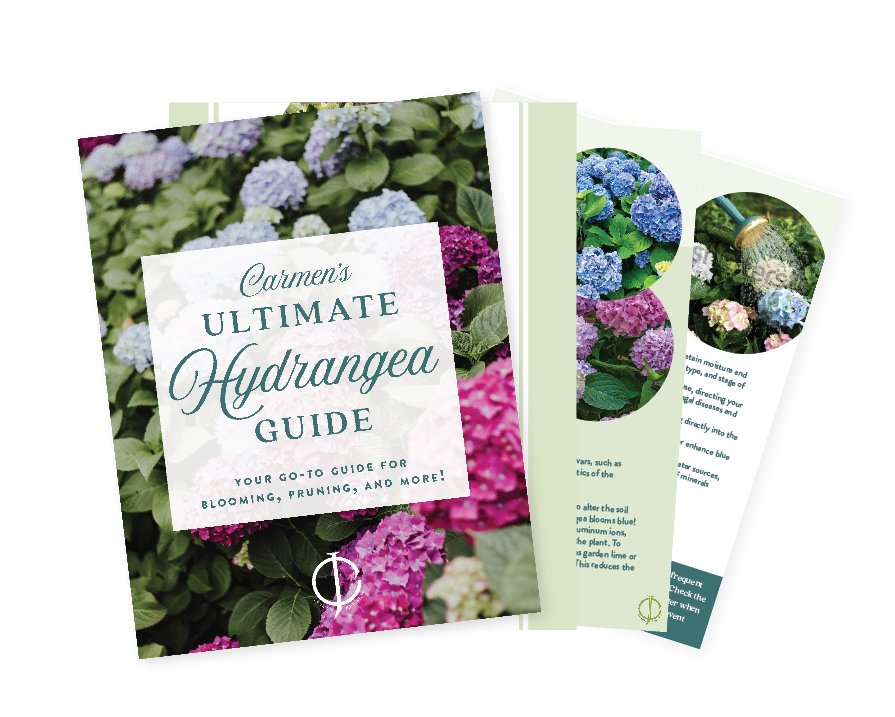All About Hydrangeas! Bloom Report, Vol. 011
Disclosure: I earn commission from qualifying affiliate purchases linked through my site. Your Weekly Bouquet of Inspiration
Hi Friend!
My hydrangeas are in FULL bloom here in south Georgia, and I’m in heaven! Hydrangea season is absolutely my favorite. I have them all over my yard, I love using them in containers, and I always sneak a few into just about every landscape plan I design.
I can’t even tell you how often I get messages full of questions about how to take care of hydrangeas. From which varieties to choose for your specific gardening zones to how to change colors from pink to blue and the right times to prune and fertilize—y’all are determined to get it just right! And I’m so excited to help!
This week’s Bloom Report is all about Hydrangeas! From watering advice to answers to your most common “what about this?” questions—and even my go-to sources for buying these beauties—it’s all in here. Plus, you’re getting FREE access to The Ultimate Hydrangea Guide!
I hope you enjoy it and, most of all, I hope your garden is bursting with hydrangea blooms this season!
XOXO, Carmen
Tired of your Cut Hydrangea blooms not lasting very long?
Key Tips to Keep Your Hydrangeas from Wilting:
💙 Cut in the Morning:
Snip your blooms early in the day when the plant is fully hydrated—but if I need them at another time, I still go for it!
💙 Use Clean, Sharp Tools:
Always use a clean, sharp pair of cutters to make your cut. Then, grab a veggie peeler and lightly scrape all four sides of the stem—this helps the stem absorb more water.
💙 Dip in Alum Powder:
Dip the ends of the stems in alum powder (you’ll find it in the spice aisle at the grocery store). It prevents the stems from sealing off and boosts water uptake. Alum is both acidic and astringent, keeping sap from clogging the stem so water can flow freely—keeping your blooms fuller, longer!
💙 Submerge the Blooms:
If wilting happens, don’t panic! Soak the entire bloom in water for several hours (I sometimes leave them overnight), and they’ll rehydrate beautifully.
And that’s how to keep your hydrangeas from wilting so quickly! 💙
Shop my favorites
Shop for my favorite items (and plants) to grow big, beautiful hydrangeas all summer long!
Fertilizer for Hydrangeas
Garden Lime (turns blooms pink)
Your Questions of the Week
How to Propagate Hydrangeas?
Take a 4–6 inch cutting from a healthy, non-flowering stem. Remove the lower leaves, dip the cut end in rooting hormone (optional but helpful), and plant it in moist potting mix. Cover with a plastic bag or humidity dome to keep it humid, and place it in bright, indirect light. Keep the soil moist, and in a few weeks, roots should form!
Once your cutting has rooted (usually after 3–4 weeks), here’s what to do next:
Check for roots:
Give the cutting a gentle tug—if you feel resistance, roots have formed!Remove the cover:
Gradually remove the plastic bag or humidity dome over a few days to help the plant adjust to normal humidity.Transplant:
Once it’s rooted and growing new leaves, transplant it into a slightly larger pot with fresh potting soil, or directly into your garden if the weather’s right.Acclimate outdoors:
If planting outside, harden it off by placing it outdoors in shade for a few hours a day, increasing time gradually over a week.Care as usual:
Water regularly and give it some TLC—your baby hydrangea is on its way to becoming a big, beautiful bloomer!
Gifts for the Hydrangea Lover
Beautiful gift ideas for anyone who LOVES hydrangeas as much as I do!
How to change your hydrangeas from blue from pink? (or vice versa)
Yes, you can change the color of your hydrangea blooms very simply! I go into semi-scientific detail over in The Ultimate Hydrangea Guide, so if you want to nerd out a little bit with me, be sure to download it!
But the simple answer is this:
To turn your hydrangeas from pink to blue, lower the soil pH by adding aluminum sulfate or a soil acidifier—blue blooms thrive in more acidic soil (pH below 6.0).
To turn your hydrangeas from blue to pink, raise the soil pH by adding garden lime—pink blooms prefer more alkaline soil (pH above 6.0).
The Ultimate Hydrangea Guide
I want to see everyone growing happy, thriving hydrangeas, so I pulled together this collection of my very best tips for getting those gorgeous blooms! I also added a few of my favorite hydrangea products that I personally use and love.
What’s Popular this week…
My favorite types of boxwoods & HOw I use them
Wintergreen is my favorite boxwood, followed by Wintergem! And the American was my favorite until she started causing problems in our gardens.
Head over to my Instagram for some tips about boxwood blight and how we fertilize the boxwoods and how we TRY to keep the blight away! Emphasis on try!💚
My FIve Favorite Ground CoverS!
My Top 5 Favorite Ground Covers! 🌿
These beauties are hardworking, low-growing, and perfect for adding texture and color to your garden beds:
Lamb’s Ear ‘Helen von Stein’ (Stachys byzantina) – Soft, silvery leaves that feel like velvet and add gorgeous contrast to green-heavy plantings.
Asiatic Jasmine (Trachelospermum asiaticum) – A tough, evergreen ground cover that spreads beautifully and handles heat like a champ.
Pachysandra (Pachysandra terminalis) – A go-to for shady spots with rich green foliage that stays lush all year long.
Ajuga (Ajuga reptans) – Low-growing and fast-spreading with beautiful purple blooms and striking foliage—great for filling in bare patches.
Mazus reptans – A charming, low-profile spreader that blooms in spring with tiny purple flowers and thrives in moist, well-drained soil.
You’ve got Hydrangea questions, I’ve got answers!
I’m sharing everything you want to know about how to care for hydrangeas!
























